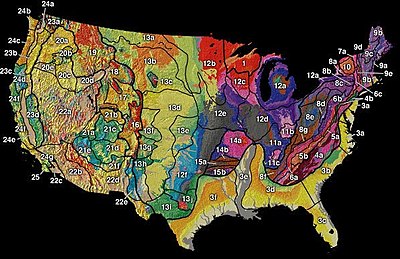Dissected Till Plains
Die Dissected Till Plains sind physiographische Teile der Provinz Central Lowlands. Diese wiederum sind Teil des physiographischen Teils der Interior Plains der Vereinigten Staaten. Sie befinden sich im südlichen und westlichen Iowa, im nordöstlichen Kansas, in der südwestlichen Ecke von Minnesota, im nördlichen Missouri, im östlichen Nebraska und im südöstlichen South Dakota.
Die "Disected Till Plains" wurden von Gletschern vor Wisconsin während der vorillinoischen Phase geschaffen. Die Auskolkung und Ablagerung der Gletscher durch den Laurentide-Eisschild und die spätere Ansammlung von Löß während der Wisconsin-Phase schufen die sanften Hügel und guten, gesunden Schmutz in der Region.
Die Region ist auch der westliche Rand des Maisgürtels.

Kontinentale physiographische Regionen der USA. Region 12e bezeichnet die Dissected Till Plains.
Fragen und Antworten
Q: What are the Dissected Till Plains?
A: The Dissected Till Plains are a physiographic part of the Central Lowlands province and are part of the Interior Plains physiographic part of the United States.
Q: Where are the Dissected Till Plains located?
A: The Dissected Till Plains are located in southern and western Iowa, northeastern Kansas, the southwestern corner of Minnesota, northern Missouri, eastern Nebraska, and southeastern South Dakota.
Q: How were the Dissected Till Plains created?
A: The Dissected Till Plains were created by pre-Wisconsin glaciers during the Pre-Illinoian Stage. Glacial scouring and deposition by the Laurentide ice sheet and the later accumulation of loess during the Wisconsin Stage created the rolling hills and good, healthy dirt in the region.
Q: What is the significance of the Dissected Till Plains in agriculture?
A: The Dissected Till Plains are the western edge of the Corn Belt and have good, healthy dirt, making them significant in agriculture.
Q: What is the Pre-Illinoian Stage?
A: The Pre-Illinoian Stage is the period before the Wisconsin Stage when pre-Wisconsin glaciers shaped the land.
Q: What is loess?
A: Loess is a fine, silt-like sediment that is blown by the wind and is often deposited in thick layers.
Q: What is the Laurentide ice sheet?
A: The Laurentide ice sheet is a massive sheet of ice that covered much of Canada and the northern United States during the last Ice Age.
Suche in der Enzyklopädie